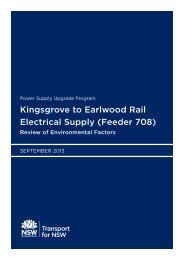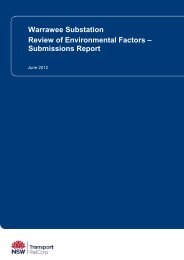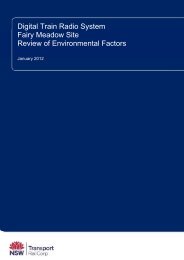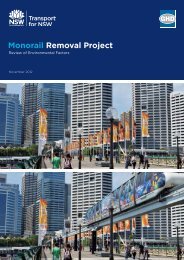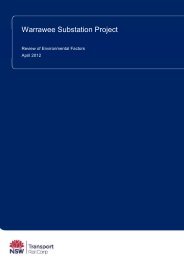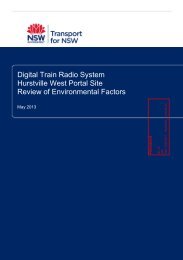Opus International Consultants (NSW) Pty Ltd - Transport for NSW ...
Opus International Consultants (NSW) Pty Ltd - Transport for NSW ...
Opus International Consultants (NSW) Pty Ltd - Transport for NSW ...
You also want an ePaper? Increase the reach of your titles
YUMPU automatically turns print PDFs into web optimized ePapers that Google loves.
Acoustic TerminologyAppendix AReport Number610.08297Page 1 of 11 Sound Level or Noise LevelThe terms “sound” and “noise” are almost interchangeable,except that in common usage “noise” is often used to refer tounwanted sound.Sound (or noise) consists of minute fluctuations inatmospheric pressure capable of evoking the sense of hearing.The human ear responds to changes in sound pressure over avery wide range. The loudest sound pressure to which thehuman ear responds is ten million times greater than thesoftest. The decibel (abbreviated as dB) scale reduces thisratio to a more manageable size by the use of logarithms.The symbols SPL, L or LP are commonly used to representSound Pressure Level. The symbol LA represents A-weightedSound Pressure Level. The standard reference unit <strong>for</strong> SoundPressure Levels expressed in decibels is 2 x 10 -5 Pa.2 “A” Weighted Sound Pressure LevelThe overall level of a sound is usually expressed in terms ofdBA, which is measured using a sound level meter with an “Aweighting”filter. This is an electronic filter having a frequencyresponse corresponding approximately to that of humanhearing.People’s hearing is most sensitive to sounds at midfrequencies (500 Hz to 4000 Hz), and less sensitive at lowerand higher frequencies. Thus, the level of a sound in dBA is agood measure of the loudness of that sound. Differentsources having the same dBA level generally sound aboutequally loud.A change of 1 dBA or 2 dBA in the level of a sound is difficult<strong>for</strong> most people to detect, whilst a 3 dBA to 5 dBA changecorresponds to a small but noticeable change in loudness. A10 dBA change corresponds to an approximate doubling orhalving in loudness. The table below lists examples of typicalnoise levelsSoundPressure Level(dBA)TypicalSourceSubjectiveEvaluation130 Threshold of pain Intolerable120 Heavy rock concert110 Grinding on steel100 Loud car horn at 3 mExtremely noisyVery noisy90 Construction site withpneumatic hammering80 Kerbside of busy street Loud70 Loud radio or television60 Department store Moderate to quiet50 General Office40 Inside private office Quiet to very quiet30 Inside bedroom20 Recording studio Almost silentOther weightings (eg B, C and D) are less commonly used thanA-weighting. Sound Levels measured without any weightingare referred to as “linear”, and the units are expressed asdB(lin) or dB.3 Sound Power LevelThe Sound Power of a source is the rate at which it emitsacoustic energy. As with Sound Pressure Levels,Sound Power Levels are expressed in decibel units (dB ordBA), but may be identified by the symbols SWL or LW, or bythe reference unit 10 -12 W.The relationship between SoundPower and Sound Pressure may be likened to an electricradiator, which is characterised by a power rating, but has aneffect on the surrounding environment that can be measuredin terms of a different parameter, temperature.4 Statistical Noise LevelsSounds that vary in level over time, such as road traffic noiseand most community noise, are commonly described in termsof the statistical exceedance levels LAN, where LAN is the A-weighted sound pressure level exceeded <strong>for</strong> N% of a givenmeasurement period. For example, the LA1 is the noise levelexceeded <strong>for</strong> 1% of the time, LA10 the noise exceeded <strong>for</strong> 10%of the time, and so on.The following figure presents a hypothetical 15 minute noisesurvey, illustrating various common statistical indices ofinterest.Sound Pressure Level (dBA)55504540353025LAmaxLA1LA10LAeqLA9000:00 05:00 10:00 15:00Monitoring or Survey Period (minutes)Of particular relevance, are:LA1 The noise level exceeded <strong>for</strong> 1% of the 15 minuteinterval.LA10 The noise level exceed <strong>for</strong> 10% of the 15 minuteinterval. This is commonly referred to as the averagemaximum noise level.LA90 The noise level exceeded <strong>for</strong> 90% of the sampleperiod. This noise level is described as the averageminimum background sound level (in the absence ofthe source under consideration), or simply thebackground level.LAeq The A-weighted equivalent noise level (basically theaverage noise level). It is defined as the steady soundlevel that contains the same amount of acousticalenergy as the corresponding time-varying sound.When dealing with numerous days of statistical noise data, it issometimes necessary to define the typical noise levels at agiven monitoring location <strong>for</strong> a particular time of day. Astandardised method is available <strong>for</strong> determining theserepresentative levels.This method produces a level representing the “repeatableminimum” LA90 noise level over the daytime and night-timemeasurement periods, as required by the EPA. In addition themethod produces mean or “average” levels representative ofthe other descriptors (LAeq, LA10, etc).5 TonalityTonal noise contains one or more prominent tones (ie distinctfrequency components), and is normally regarded as moreoffensive than “broad band” noise.Heggies <strong>Pty</strong> <strong>Ltd</strong>A member of SLR Group



